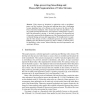Free Online Productivity Tools
i2Speak
i2Symbol
i2OCR
iTex2Img
iWeb2Print
iWeb2Shot
i2Type
iPdf2Split
iPdf2Merge
i2Bopomofo
i2Arabic
i2Style
i2Image
i2PDF
iLatex2Rtf
Sci2ools
ECCV
2008
Springer
2008
Springer
Edge-Preserving Smoothing and Mean-Shift Segmentation of Video Streams
Video streams are ubiquitous in applications such as surveillance, games, and live broadcast. Processing and analyzing these data is challenging because algorithms have to be efficient in order to process the data on the fly. From a theoretical standpoint, video streams have their own specificities ? they mix spatial and temporal dimensions, and compared to standard video sequences, half of the information is missing, i.e. the future is unknown. The theoretical part of our work is motivated by the ubiquitous use of the Gaussian kernel in tools such as bilateral filtering and mean-shift segmentation. We formally derive its equivalent for video streams as well as a dedicated expression of isotropic diffusion. Building upon this theoretical ground, we adapt a number of classical powerful algorithms to video streams: bilateral filtering, mean-shift segmentation, and anisotropic diffusion.
Bilateral Filtering | Classical Powerful Algorithms | Computer Vision | ECCV 2008 | Mean-shift Segmentation | Theoretical Standpoint | Video Streams |
| Added | 15 Oct 2009 |
| Updated | 15 Oct 2009 |
| Type | Conference |
| Year | 2008 |
| Where | ECCV |
| Authors | Sylvain Paris |
Comments (0)

